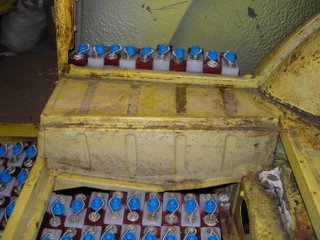A Battery of Cells.

That's right, my car doesn't have a bunch of batteries, only one- but it's made up of 280 individual 1.2 volt cells. These are no ordinary lead slugs, no, but nickel-cadmium wet cells. BB-600 spec, to be exact in US military parlance, as these batteries were originally purchased by Uncle Sam as starting cells for tactical jet aircraft. These little babies are rated to deliver 1800 cold cranking amperes, and each cell contains at least 34 amp-hours of juice. Nicads have many advantages over lead-acid cells, not least among which is their ability to fully recover from complete discharge. As a matter of fact, proper storage technique calls for running down the cells and shorting them out with a jumper! These cells have been proven to deliver beyond their rated capacity at 30 years of age, so why did Uncle Sam discard these cells after only three years on a shelf? Heck if I know, I guess that complete reliability is paramount when defending the free world, but I'll be happy to reuse castoffs like these anytime, for 1/464th the original cost, thanks to fellow EV'er Tim Humphreys, who scored of a truckload of these units in a surplus auction.
How to fit them into the Karmann Eclectric? Well, thankfully my battery boxes were designed for the maximum space possible, to fit even the 10 7/8" tall T-105 6 volt battery, that old reliable golf cart battery. The 9 1/4" bb600 cells fit quite nicely in my boxes, so snugly that one would thing they were designed for them all along...
The front battery box, shown above holding 64 cells (@ 220 lbs, once wired) was built by Doug Weathers for his Ghia, but when he decided on a different battery model, this one was surplused. The front pack is offset to the passenger side because the steering column passes too close on the right (and provides weight balance). There's room for a 10-cell stack on top of that filler plate if necessary. I like the clean look it has right now, but one thing to consider for optimal weight distribution is to get more batteries further forward. There's room in the trunk to mount a larger number of these cells atop a flat plate, rather than sunken into the gas tank void, as shown.  The main battery boxes are in the rear seat area. Here we have several options. Since the nicads have to be watered on a regular basis, easy access would be a plus. As shown here, 76 cells fit on each side with unfettered access. What you can't see is that an additional 25 cells per side are hidden from view. Additional trimming of the body wil be required to provide access for maintaining these cells, or I could just put filler in those inaccessible spaces. 101 cells per side, plus 64 up front gets us within 14 cells of our 280 unit goal. Well, it so happens that ten cells fit perfectly within each quarter panel, giving six cells spare.
The main battery boxes are in the rear seat area. Here we have several options. Since the nicads have to be watered on a regular basis, easy access would be a plus. As shown here, 76 cells fit on each side with unfettered access. What you can't see is that an additional 25 cells per side are hidden from view. Additional trimming of the body wil be required to provide access for maintaining these cells, or I could just put filler in those inaccessible spaces. 101 cells per side, plus 64 up front gets us within 14 cells of our 280 unit goal. Well, it so happens that ten cells fit perfectly within each quarter panel, giving six cells spare.
With a simple box added to each rear quarter panel, 20 cells will be easily accessible for maintenance. And don't worry, even the quarter panels can be ventilated for proper Hydrogen management.
This shot also shows how the rear seat sidewall interferes with maintenance of the outermost cells of the lower rear pack. Enlarging the front pack and keeping the rear packs to 75 or 76 cells apiece would provide for not only better balance (ironically at the expense of a slightly higher center of gravity), but also eliminate the need to hack up my rear seat, and perhaps also reduce the need for small packs scattered throughout the car. Stuffing small cells into every available niche would seem advantageous, but it increases the chances for trouble with balance of charge due to temperature variations and numerous long interconnects. A single massive pack is better for battery management. Of course, compromise is the name of our conversion game, more to come after some head scratching...



